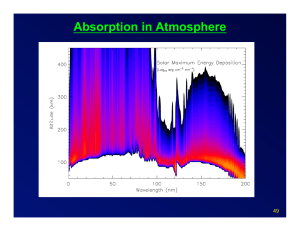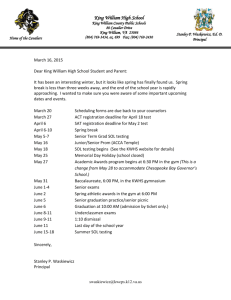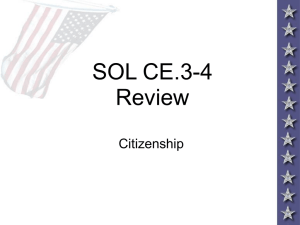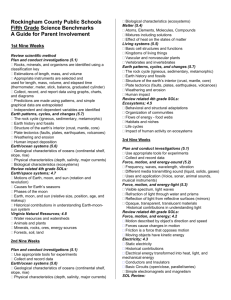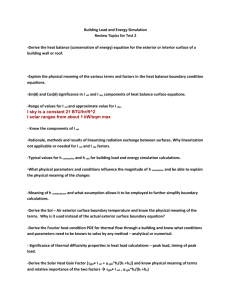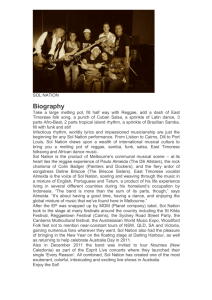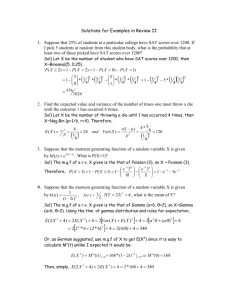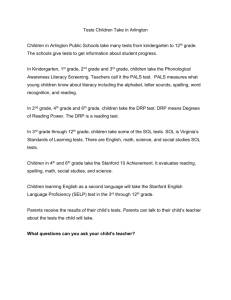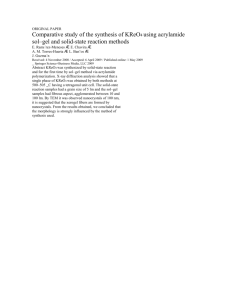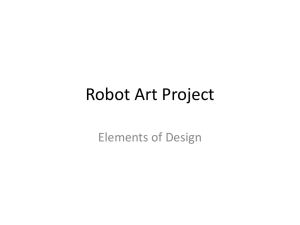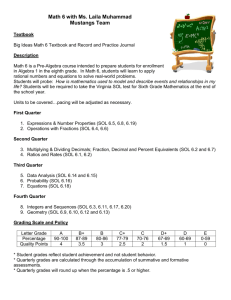DRAFT Rockingham County Public Schools Earth Science
advertisement
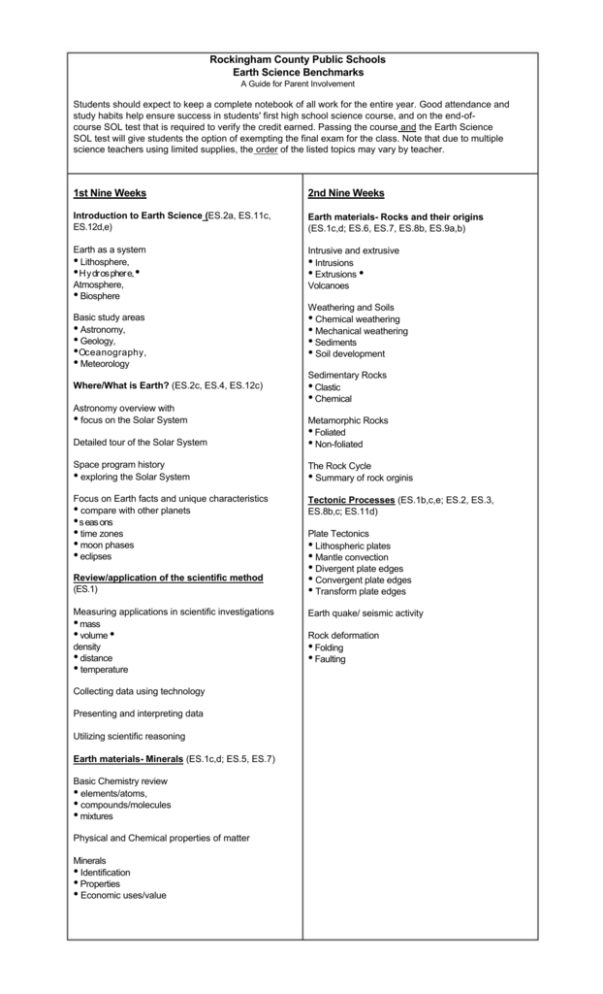
Rockingham County Public Schools Earth Science Benchmarks A Guide for Parent Involvement Students should expect to keep a complete notebook of all work for the entire year. Good attendance and study habits help ensure success in students' first high school science course, and on the end-ofcourse SOL test that is required to verify the credit earned. Passing the course and the Earth Science SOL test will give students the option of exempting the final exam for the class. Note that due to multiple science teachers using limited supplies, the order of the listed topics may vary by teacher. 1st Nine Weeks 2nd Nine Weeks Introduction to Earth Science (ES.2a, ES.11c, ES.12d,e) Earth materials- Rocks and their origins (ES.1c,d; ES.6, ES.7, ES.8b, ES.9a,b) Earth as a system • Lithosphere, • H y dr os pher e, • Atmosphere, • Biosphere Intrusive and extrusive • Intrusions • Extrusions • Volcanoes Basic study areas • Astronomy, • Geology, • Oc e a n og r a ph y, • Meteorology Where/What is Earth? (ES.2c, ES.4, ES.12c) Astronomy overview with • focus on the Solar System Weathering and Soils • Chemical weathering • Mechanical weathering • Sediments • Soil development Sedimentary Rocks • Clastic • Chemical Detailed tour of the Solar System Metamorphic Rocks • Foliated • Non-foliated Space program history • exploring the Solar System The Rock Cycle • Summary of rock orginis Focus on Earth facts and unique characteristics • compare with other planets • s eas ons • time zones • moon phases • eclipses Tectonic Processes (ES.1b,c,e; ES.2, ES.3, ES.8b,c; ES.11d) Review/application of the scientific method (ES.1) Measuring applications in scientific investigations • mass • volume • density • distance • temperature Collecting data using technology Presenting and interpreting data Utilizing scientific reasoning Earth materials- Minerals (ES.1c,d; ES.5, ES.7) Basic Chemistry review • elements/atoms, • compounds/molecules • mixtures Physical and Chemical properties of matter Minerals • Identification • Properties • Economic uses/value Plate Tectonics • Lithospheric plates • Mantle convection • Divergent plate edges • Convergent plate edges • Transform plate edges Earth quake/ seismic activity Rock deformation • Folding • Faulting 3rd Nine Weeks 4th Nine Weeks Landscape Development (ES.1b,c; ES.2a, ES.3, ES.8b, ES.9) The Atmosphere (ES.1a,b; ES.2a, ES.3a,b; ES.11c, ES.12, ES.13) Erosion and deposition Meteorology, Weather, Climate Agents of landscape development • Gravity/mass wasting • Running water • Wind • Glaciers • W av es Composition, layers, changes over time Impact of natural phenomena and human activity Comparison with other planets Weather instruments, weather data, and maps Groundwater and karst topography Watershed systems in Virginia Topographic Maps • Interpretation of landforms • Latitude • Longitude Earth History (ES.10) Relative and absolute age-dating Fossil record Geologic Time Scale Geology of Virginia (ES.7, ES.8a, ES.9f, ES.10) Weather Patterns • Winds • Humidity • Air pressure • Temperature • Cloud formation • Air masses • Fronts • Storms • Forecasting Summarize relationships among the interactive parts of the Earth's System Return to Outer Space (ES.1e, ES.2, ES.4, ES.14) Physiographic provinces Geologic history R es our c es • Renewable vs. nonrenewable Review Earth's place in the Solar System • The galaxy • The universe The World Ocean (ES.2a, ES.3, ES.9, ES.11) Evolution of the stars and our Sun Water distribution, Water Cycle H-R Diagram Physical and chemical changes • Tides • W av es • Currents • Stored heat and its affect on weather Galaxies and the Universe Economic resources Earth Science End-of-Course SOL TEST REVIEW Origin of the Solar System and the Universe Space Exploration Influence of tectonic processes Environmental issues and the impact of human activities Students should: 1. Review all class notes, quizzes, and tests. 2. Practice test-taking skills with sample questions. 3. Be well-rested and prepared for the SOL test. Teachers should: 1. Use example questions as warm-ups or for analysis by the class. 2. Provide students with practice web sites that have released SOL test questions available in a quiz or game format. 3. Hold review sessions that cover the Essentials from the Earth Science Curriculum Framework provided to teachers by the VA Department of Education. The Earth Science EOC SOL Test Projects/ labs (as time allows) ** The numbers throughout the Benchmarks refer to the Virginia Science Standards of Learning objectives. For example, "ES.4" refers to Earth Science SOL objective number "4".

